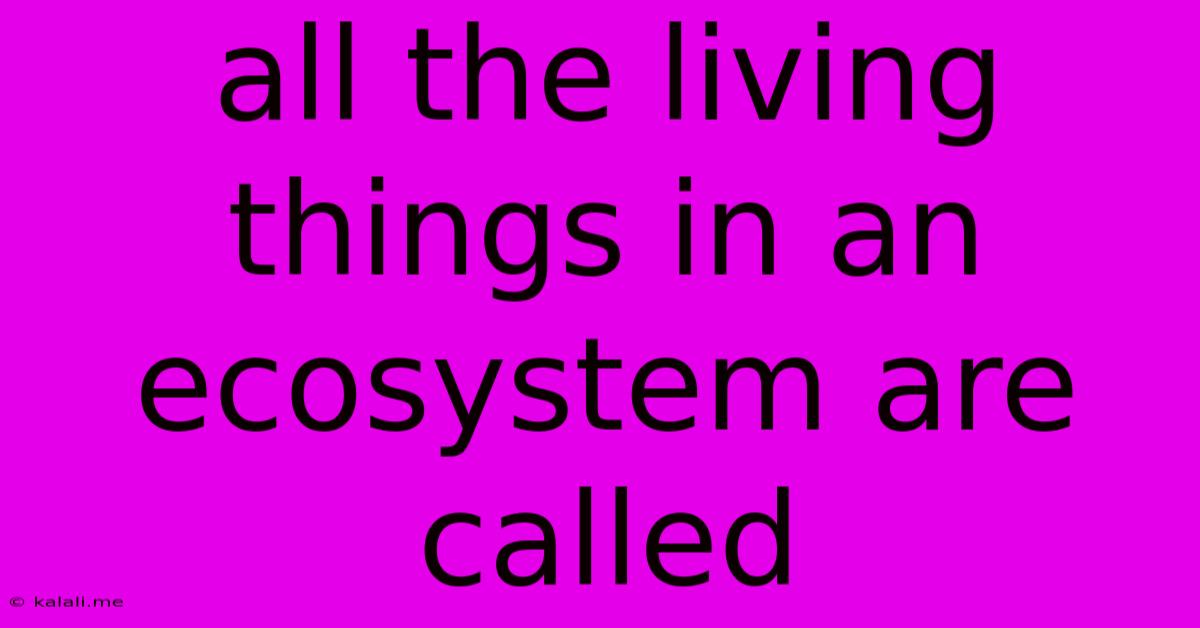All The Living Things In An Ecosystem Are Called
Kalali
Jun 14, 2025 · 3 min read

Table of Contents
All the Living Things in an Ecosystem are Called a Community
Have you ever stopped to consider the intricate web of life that exists within a single ecosystem? From the towering redwood trees to the microscopic bacteria in the soil, every living organism plays a vital role. Understanding this interconnectedness is key to appreciating the delicate balance of nature. This article explores the term used to describe all the living things within an ecosystem: a biological community. We'll delve into what constitutes a community, its relationship with the abiotic factors, and the importance of biodiversity within these intricate systems.
A biological community, also known as an ecological community, encompasses all the populations of different species that interact within a defined area or habitat. This interaction is crucial; it’s not simply a collection of individual organisms living together, but rather a dynamic system where species influence each other through competition, predation, symbiosis, and other ecological relationships. Think of a forest: it's not just trees; it's trees, birds, insects, fungi, mammals, and countless microorganisms, all interacting and influencing one another's survival and reproduction.
Key Components of a Biological Community:
- Producers: These are the autotrophs, primarily plants and algae, that produce their own food through photosynthesis. They form the base of the food web, providing energy for all other organisms.
- Consumers: These are the heterotrophs that obtain energy by consuming other organisms. This group includes herbivores (plant-eaters), carnivores (meat-eaters), and omnivores (both plant and meat-eaters). Decomposers, like bacteria and fungi, are also crucial consumers, breaking down dead organic matter and recycling nutrients back into the ecosystem.
- Decomposers: Essential for nutrient cycling, these organisms break down dead plants and animals, releasing nutrients back into the environment for producers to utilize. This continuous cycle of life and death is fundamental to the health of the ecosystem.
The Relationship Between Community and Ecosystem:
It's important to differentiate between a biological community and an ecosystem. While a community focuses solely on the living components (biotic factors), an ecosystem encompasses both the living organisms (biotic factors) and their non-living environment (abiotic factors). Abiotic factors include things like temperature, rainfall, sunlight, soil type, and water availability. These factors significantly influence the composition and structure of the biological community. For instance, a desert community will be drastically different from a rainforest community due to the stark differences in their abiotic factors.
Biodiversity and Community Stability:
A diverse community, one with a high number of species and a rich variety of interactions between them, is generally more resilient and stable. Greater biodiversity provides a buffer against environmental changes and disturbances. If one species is affected by disease or a natural disaster, other species can often fill the ecological niche, maintaining the overall health of the community. Loss of biodiversity, on the other hand, can lead to ecosystem instability and vulnerability.
Examples of Biological Communities:
- Coral Reefs: A vibrant community teeming with fish, corals, invertebrates, and algae.
- Rainforests: Incredibly diverse communities with a wide array of plants, animals, and microorganisms.
- Grasslands: Communities dominated by grasses, with herbivores like zebras and wildebeest, and predators like lions and cheetahs.
- Estuaries: Transition zones between freshwater and saltwater, supporting diverse communities adapted to brackish water conditions.
In conclusion, all the living things within an ecosystem are collectively referred to as a biological community. This community is not just a random assortment of organisms, but a complex and interconnected system where each species plays a crucial role in shaping the overall structure and function of the ecosystem. Understanding the intricate relationships within these communities is vital for conservation efforts and ensuring the health of our planet.
Latest Posts
Latest Posts
-
The Sum Of 3 Consecutive Integers
Jun 14, 2025
-
Sugar In Dna Vs Sugar In Rna
Jun 14, 2025
-
The Price Of An Item Was Lowered By 25
Jun 14, 2025
-
Gpa Requirements For Virginia State University
Jun 14, 2025
-
Square Root Of 441 By Long Division Method
Jun 14, 2025
Related Post
Thank you for visiting our website which covers about All The Living Things In An Ecosystem Are Called . We hope the information provided has been useful to you. Feel free to contact us if you have any questions or need further assistance. See you next time and don't miss to bookmark.